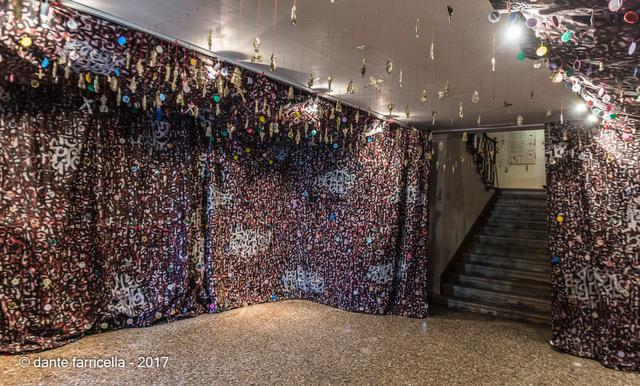Speciale
Nigeria Now
When Dante Farricella (the art director of Sisters’ Grace) asked Peju Alatise to choose a place to be photographed, she was puzzled: "That’s not the kind of decision that is left to me when they set up an exhibition of my works." "But you are the artist," he replied. "No one can know better than you what your place is amid your works.”
She then chose to sit near the door that appears in her Flying Girls installation: eight little girls in a circle, all with small wings, wrapped in a cloud of swallows and surrounded by a sea of butterflies. The white, aerial door, which opens to an unknown somewhere, was decorated with a small orange rosette for this occasion. "The color of rebellion, according to my father. He promised me he would come with me. He left us before his time, and so I brought his color here." ‘Here’ is Venice, at the 57th Edition of the Biennale of Art. Peju, along with Victor Ehikhamenor and Qudus Onikeku, has been selected to represent Nigeria for the first time at what is called the Olympics of Art. The space allocated for this is the Scoletta dei Battioro e Tiraoro, near the San Stae church. If coming by boat along the Grand Canal, it is easy to see; by foot, however, is a bit more complicated. We’ve gotten lost many times. But persistence is well-rewarded in the end. The Nigeria pavilion, with its minimalism, proved to be one of the most successful of this Biennale, and we have had the pleasure and privilege of speaking with the artists, and with Emmanuel Iduma, writer and exhibition co-curator.

From left: Emmanuel Iduma, Victor Ehikhamenor and Qudus Onikeku.
Nigeria has recently been presented in Western media as the driving force behind the so-called African cultural and artistic renaissance. Certainly in Lagos (or at least in certain areas) there are galleries, auction houses, cultural centers and exhibition spaces. Many artists (Alatise and Ehikhamenor among them) have seen market prices for their works rise rapidly. But when asked about this explosion in Nigerian art, they do not like the word choice. "It's an incorrect concept," says Ehikhamenor. "What is true is that in the past, to become known abroad, we had to wait for a Westerner to ‘discover’ us.” Today, thanks to the Internet and social networks, we can promote our work independently. If there has been a ‘boom’, it is not about creative production, but its transmission outside of traditional borders." How can we disagree? Nigeria boasts a very ancient artistic tradition, which goes far beyond the colonial era—you need only look to the NOK culture or the Kingdom of Ife or Benin. A number of highly-respected art collectives were established there, such as the Zaria Art Society (late 1950s) or the Nsukka group (from the 70s). The quality, quantity and originality of current productions come from these premises. There is a continuum that holds the story together. Considering and presenting as novelty something previously unknown to us – meaning, considering oneself as a measure of all things – is a very common human weakness, almost a venial sin. But if those who do it have the power, for example, to pack and label cultural phenomena, it can become very treacherous because it can lead to distortion of reality, to negation of the past. The Biography of Forgotten, Ehikhamenor's immersive work that welcomes those who enter the Scoletta, wants to reverse this distorted view.

The Biography of Forgotten by Victor Ehikhamenor.
It is an enveloping installation, specially designed for Venice. Seven large cloth drapes cover the walls, filled with graphics that characterize the works of this eclectic artist, and get their inspiration from signs and marks on the homes and sacred buildings of Udomi-Uwessan, his native village near Benin City. Hundreds of mirrors are applied to the drapes, which mirror not only the viewer’s image, but also the glitter of a series of traditional sculptures that descend from the ceiling, intertwining reflections and symbols that are also references to colonial issues. As Ehikhamenor explains, "Mirrors have been one of the main commodities used by whites to take away men, resources and even artworks from Nigeria." Any attempt at reparations for the trauma inflicted by colonialism cannot exist without a full awareness of the present and a reconstruction of memories. It is in this view that Ehikhamenor takes a (critical) position with respect to Damien Hirst's Golden Heads, exhibited at Palazzo Grassi on the occasion of the Biennale, which is essentially a copy of the bronze Head of Ife acquired by the British Museum. He does not discuss the legitimacy of plagiarism itself, but the fact that Hirst puts forth the sculpture without contextualizing it: in a world essentially ignorant of Africa and full of assumptions, this will inevitably lead at some point to the accusation that Nigerians imitated Hirst. "That's why we need, now more than ever, more biographers for our forgotten."

Qudus Onikeku.
We climb a stairway, enter a tent, and there running in front of us is the Qudus Onikeku trilogy, Right Here, Right Now. There are three performances by which this acrobat-dancer, who studied in France but remains firmly anchored to his Yoruba roots, connects the memories of the body, sense of identity, and concept of dance. "The body has a memory of everything," says Onikeku. "My traumas, but also those of my father and grandfather. And this memory can be activated through dance and brings us to rediscover things swept away by colonial narrative." It is a way to recover and renew a collective unconscious that maintains continuity between body and spirit. Carl Gustav Jung may come to the Western viewer’s mind. But in reality this view is at the heart of Yoruba thinking, which unites what in other cultures is analytically opposed. "When they tell me that art can be a tool for social transformation, I find that difficult to understand," the artist continues. "In my language, there is one word to indicate art and life. It is not conceivable that art is not intrinsically linked to life and vice versa." Onikeku's dance does not have an aesthetic purpose, but a narrative and investigative one. It is a tool to delve into, remember, connect the here and now.

Flying Girls by Peju Alatise.
Another ramp and there are the Flying Girls waiting for us. Peju Alatise is not only a sculptor and painter, but also a poet and writer. She likes to say about herself, "I have never become an artist. I have just always been. I always wanted to paint and do creative things." I already knew of her because of her High Horses triptych, sold a few years ago at a Bonhams auction for 40 thousand euros. Three mannequins hoisted on tall stands, wrapped in sumptuous fabrics, affecting the senses while completely hiding the faces: a work that staged and questioned the fate of invisibility and silence assigned to too many women in Nigeria. Girls with wings have a beauty and an even greater impact. The inspiration for this work is a story written by Peju, who speaks of Sim, a small Yoruba domestic slave balancing between two realities: the killing workload of a wealthy family of Lagos, and a dream world—the dream of flying free like a swallow or butterfly. The little girls in the circle, with their androgynous bodies and hairstyles that would be well-suited among the photographs of Nigerian photographer J.D. Okhai Ojeikere, are all small Sims and condemn a deep plague in contemporary Nigeria—Something about which, if you care about this country, you cannot keep silent.

Emmanuel Iduma.
How About Now is the title-question that joint curators Iduma and Adenrele Sonariwo — director of the Relay Gallery of Lagos—chose for this tripartite and unified setup. From distinct perspectives, using profoundly different artistic languages and materials, Ehikhamenor, Onikeku, and Alatise create a choral narrative, articulated between the present and the memory, stretching towards the truth and with awareness of contradictions. "We've been thinking for a long time about what could be the best way to represent a country like ours, which indirectly, through individual participation or Okwui Enwezor's artistic direction, had already been present at the Venice Biennale," Iduma told us. "And it seemed that a connection between artistic legacy and national identity could be the key to answer essential questions such as ‘How about now?’ We chose artists who, in line with the theme of the Biennale, bring art alive, looking to the future, but strongly feeling the theme of belonging."
Post-Script: Africa at the 2017 Biennale.
This time there is not a lot of Africa in Venice. Among the invited artists there are two sub-Saharans: Nigerian Jelili Atiku, known for his strong and courageous performances of condemnation, and Malian Abdoulaye Konate, who mainly expresses himself with works in fabric. Then there are also Moroccans Younes Rahmoun and Touloub Achraf; Egyptian Hassan Khan; and French-Algerian Kader Attia who, with his exhibition of sounds, movement and couscous gives further proof of his great visionary talent and the strength of his roots. There are also three African-Americans: Sam Gilliam, Senga Nengudi and McArthur Bionion. But it still is a long way from the previous edition, curated by Okwui Enwezor and characterized by a rich and varied African presence (19 invited artists, not including the collective Invisible Borders).
National participation, however, rose to nine (compared to five two years ago): Angola, Ivory Coast, Egypt, Seychelles, South Africa, Tunisia, Zimbabwe, and, of course, the debut of Nigeria. Kenya is also represented, albeit after a number of adjustments. After the scandal of the past edition (with the pavilion contracted to Chinese artists through an Italian curatorship, which was out of context of the local creative scene and halted in extremis, with many apologies, thanks to the energetic protest of Kenyan artists and intellectuals), the government announced a true participation. But a few days before the inauguration, and for reasons not entirely clear (a problem of money? Visas? Political vengeance?), the country has disappeared from the programs and press kits. The curator and artists decided to self-produce the exhibition, you can find it at the Palladio school in Giudecca. The exhibition is called Another Country, a title that explicitly refers to James Baldwin and aspires to remind everyone that another country, another world is possible. You just have to be willing to work for it.
Stefania Ragusa –Sisters’ Grace
Photos: Dante Farricella– Sisters’ Grace
Translation by Laura Giacalone.
With the support of 









